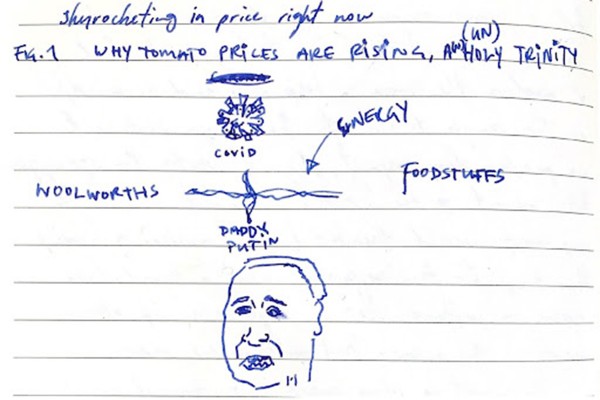A year ago, a kg of tomatoes from Centre City New World cost $2.99. Today, those same juicy round bois have almost doubled in price, costing $5.49. In a quest to find out why hurling rotten tomatoes isn’t the affordable pastime it used to be, Critic Te Arohi consulted Professor of Sociology Hugh Campbell, who teaches a paper on the “Global Politics of Food”.
Keen shoppers would have noticed grocery prices spiking recently, and no, it’s not all in your head. Stats NZ found grocery prices went up 5.4% as a whole in Feb compared to a year ago, with meat 7% more expensive, and fruit and veg a whopping 17% costlier. Hugh attributed this to a number of factors, one of which is the supermarket duopoly in New Zealand. The two big players, Australian-owned Woolworths (Countdown and FreshChoice) and Kiwi Foodstuffs (New World, Pak ‘N Save and Four Square), sweep up 80-90% of NZ’s grocery spend every year. Hugh said this contributes significantly to how expensive food is: “We have a hugely concentrated and uncompetitive supermarket sector in NZ which gouges the suppliers who provide it with things like veges, and then charges massively for consumers. It is a real structural problem in our food retail system.”
Alongside this, the pandemic has exposed what Hugh terms “the guilty secret of NZ fruit and vegetable production”. According to Hugh, to keep costs down (partly due to supermarket pricing pressure), most of the fruit and veges you eat had been picked by contract labourers, brought in for cheap on temporary work visas, primarily from the Pacific, the Philippines and India. “With the pandemic,” Hugh says, “they can’t get those cheap workers any more, and because they’ve grown used to having that cheap labour, the whole market has fallen apart. [Growers] don’t pay high enough wages, have safe enough conditions, or decent enough housing for NZ fruit or vegetable pickers. So, they are simply leaving a whole lot of fruit and veges to rot unharvested. That is (also) helping drive up prices in the supermarket.”
Finally, Hugh predicts energy prices will begin to play a bigger role in this royal clusterfuck of factors. The price of oil has jumped by around 50% since Christmas, largely blamed on increasing global demand as lockdowns end and, more recently, widespread sanctions on Russia (a major oil exporter). “It hasn’t become a big part of the story yet, but over the next few months, the dramatically rising price of global oil is going to drive up a whole lot of food prices in NZ. This is because energy from oil is embedded in a whole lot of parts of our intensive agricultural and horticultural systems.” So we have that to look forward to.



